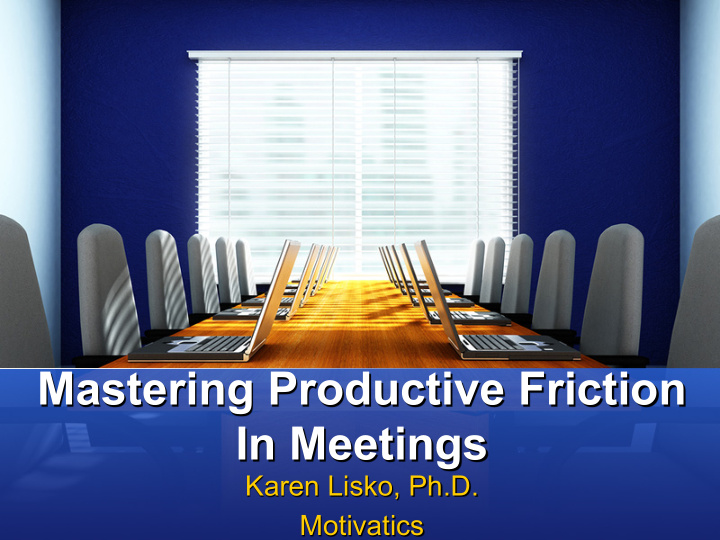



Mastering Productive Friction In Meetings Karen Lisko, Ph.D. Motivatics
Research finds that a predominant tone of ☐ True cooperation in meetings produces ☐ False better decisions (and more profits). (Schulz-Hardt et al. 2006)
Research finds that a predominant tone of ☐ True cooperation in meetings produces ☐ False better decisions (and more profits). (Schulz-Hardt et al. 2006)
Mastering Productive Friction The Five “C’s”
Mastering Productive Friction The Five “C’s”
“Productive Friction” Meeting Rules: The “Everyone/Anyone/No One” Model 1. Everyone puts their perspectives on the table 2. Everyone i supports the final decision 3. Anyone “mines” for diverse opinions (conflict) 4. Anyonee interrupts tension with reminder of importance 5. No one prevents diverse opinions (conflict) from being fleshed out 6. No one stomps out/shuts down
Different Types of Conflicts Work Differently Benefits to Decision Making and Profits Relationship Task Conflicts Conflicts x Jen & Chatman (2000) Chatman (1999)
What is your . . . F I R S T D S E C O N REACTION?
Mastering Productive Friction The Five “C’s”
Do you know your “conflict self?” “Mirror in the Chair” Exercise Q1. How do I add value to the team when we are in conflict? Q2. How do I detract from the team when we are in conflict? Q3. Do I seem more oriented toward relationship conflict or task conflict?
Listen Up, Bosses! The Two Golden Rules of Leading in Task Conflict Rule #1: Rule #2: I’m the “What.” If necessary … You are the “How.” * … scale it back a notch … *And, by the way, I break the ties and have final say.
“Assertiveness in Conflict” Continuum Assertive Nonassertive Aggressive
“Assertiveness in Conflict” Continuum Assertive Nonassertive Aggressive
“Assertiveness in Conflict” Continuum Assertive Nonassertive Aggressive Declarative Loud volume Interruptive
“Assertiveness in Conflict” Continuum Assertive Upward Nonassertive Questioning Aggressive inflection sentences Slower Softer volume rate Indirect eye Interrupted contact
“Assertiveness in Conflict” Continuum Assertive Direct eye Declarative contact sentences Faster rate Firm of speech volume Downward Non- Inflection Interruptive
Structure Your Point Effectively: The Five Sentence Challenge 1. One-Sentence Attention 2. What (is the issue)? 3. Why (Is it significant)? 4. Where (does that leave us)? 5. One-Sentence Send-Off
Mastering Productive Friction The Five “C’s”
Two “Must Have” Roles in Productive Friction
Mastering Productive Friction The Five “C’s”
Dih-VER-si-tee* *
Wait a minute . . . Aren’t people . . . people?
Are there exceptions? x
*Western European Industrialized Rich Democratic Societies x
Collectivists Individualists 29
Collectivists Individualists 30
Collectivists Individualists Indonesia Colombia United States Venezuela Australia Panama Great Britain Ecuador Canada Guatemala Netherlands China New Zealand Taiwan Korea Japan 31 Mexico
Collectivists Individualists 32
Collectivists Individualists 33
Collectivists Individualists 34
Collectivists Individualists 35
. . . AND there’s a remedy Mason & O’Reilly (2014)
Do Women Have to Talk Like Men? x
Collectivists Individualists Social Minimal Interaction Critical (in Task Mode) Sign of assertiveness Direct Sign of Communication rudeness Admission of fault Silence Self-discipline More comfortable Negative Less comfortable with them Interactions with them Avoiding Dysfunctional Confronting confrontation (lacks self-discipline) Neutral Mediator Related X 38 X x
Research finds that is healthy for companies. ☐ True ☐ False
Research finds that is healthy for companies. ☐ True ☐ False
Research finds that is healthy for companies. ☐ True ☐ False
Research finds that is healthy for companies. ☐ True ý False
By Far the Most Effective *All-Inclusive Multiculturalism Ely & Thomas (2001) x
x Hymowitz (2005) Stevens et al. (2008)
Individualists Talking with Collectivists Take “face maintenance” seriously. Practice “gracious fighting/way out.” Do not push against silence. Use qualifiers, disclaimers, tentatives. Practice “no”-avoidance. x Ting-Toomey (1994)
Collectivists Talking with Individualists Focus on problem solving. Separate relationship from task. Open conflict dialogue with upfront thesis statement. Verbally self-disclose and use “I” statements. Engage in “floor-grabbing” behavior. x Ting-Toomey (1994)
☐ True ☐ False Amason & Schweiger (1994)
ý True ☐ False Amason & Schweiger (1994)
Mastering Productive Friction The Five “C’s”
A g e n d a I I . I . S t r a U t e p g d y a t e s A . A W . h a F t i n s a h n o c u i l a d l s o w u e r c l o o g n o v e d y e s i n B i g . n ? M a r k e B t . i n g H R o e w p o d r o t w e m C a o . t t t i e v C n a d t o a e m n b p c e a e t t n a e y t r R t r e a i t n r e i n a g t C ? . D H . o w O d f f o i c e w e R b e r m c i o d o m g d e S m e c l h u n e i d c u a l t e i o n w i I t I h I . I T ? D e c i s i o n s A . W h a t t o d o a p b o a u r t t y h i n o l i a d a d y o w n y e a r ?
Mastering Productive Friction The Five “C’s”
So, in conclusion, back to boredom . . . Craparo, et al. (2013)
klisko@motivatics.com Mastering Productive Friction In Meetings Karen Lisko, Ph.D. Motivatics
Recommend
More recommend